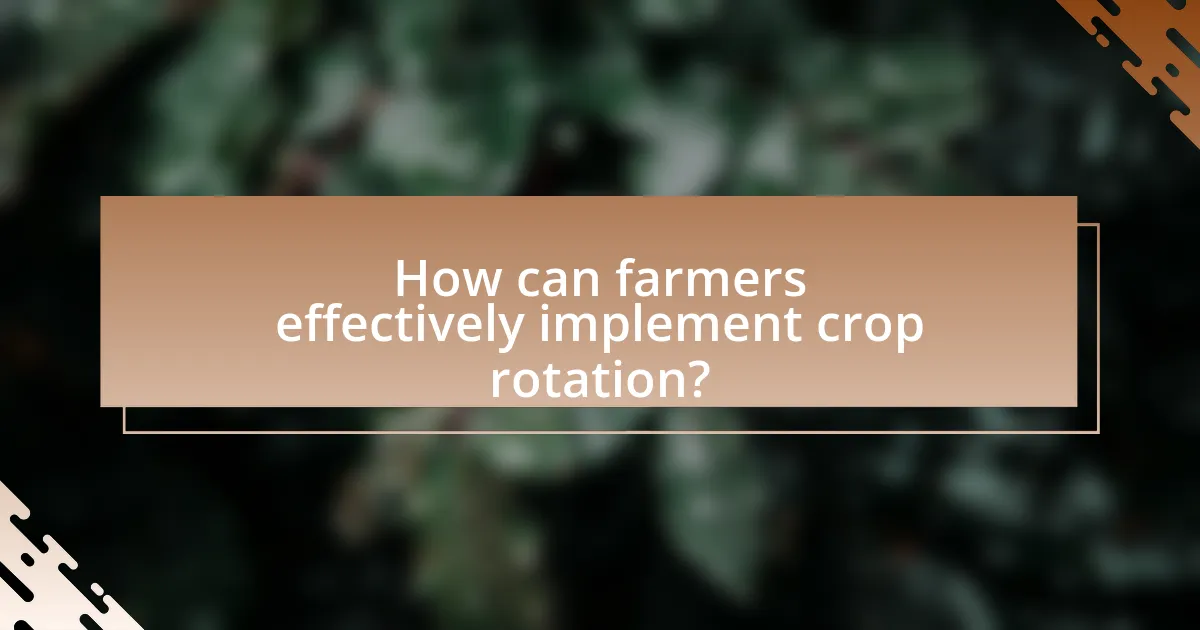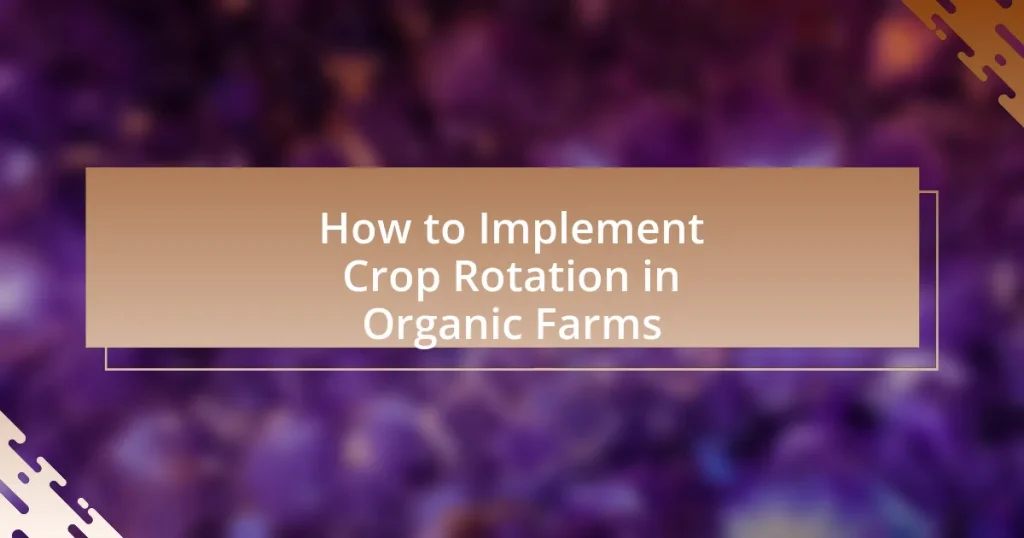Crop rotation in organic farming is a sustainable agricultural practice that involves alternating different types of crops in a specific area over time to enhance soil health, improve crop yields, and reduce pest and disease pressures. This article outlines the benefits of crop rotation, including increased soil fertility, enhanced biodiversity, and effective pest management. It also discusses the principles of planning a crop rotation schedule, the factors to consider, and the best practices for successful implementation. Additionally, the article highlights the importance of monitoring soil health and adjusting rotation plans based on results, as well as the role of education and community support in optimizing crop rotation strategies.

What is Crop Rotation in Organic Farming?
Crop rotation in organic farming is the practice of alternating the types of crops grown in a specific area over different seasons or years. This method enhances soil fertility, reduces pest and disease cycles, and improves crop yields by utilizing diverse plant families that contribute various nutrients to the soil. Research indicates that crop rotation can lead to a 10-20% increase in crop productivity compared to continuous cropping systems, as it helps maintain soil health and biodiversity.
How does crop rotation benefit organic farms?
Crop rotation benefits organic farms by enhancing soil fertility and reducing pest and disease pressure. By alternating different crops, organic farmers can improve nutrient cycling, as various plants contribute and extract different nutrients from the soil. For instance, legumes fix nitrogen, enriching the soil for subsequent crops. Additionally, rotating crops disrupts the life cycles of pests and diseases that thrive on specific plants, leading to healthier crops and reduced reliance on organic pesticides. Research indicates that farms practicing crop rotation can see yield increases of up to 20% compared to monoculture systems, demonstrating the effectiveness of this practice in organic farming.
What are the ecological advantages of crop rotation?
Crop rotation enhances soil health, reduces pest and disease pressure, and improves biodiversity. By alternating different crops, soil nutrients are replenished, as various plants have unique nutrient requirements and contributions. For instance, legumes fix nitrogen in the soil, benefiting subsequent crops. Additionally, crop rotation disrupts the life cycles of pests and diseases that thrive on specific crops, leading to lower reliance on chemical pesticides. Research indicates that farms practicing crop rotation can see a 10-20% increase in yield stability and a significant reduction in soil erosion, thereby promoting a more sustainable agricultural ecosystem.
How does crop rotation improve soil health?
Crop rotation improves soil health by enhancing nutrient availability, reducing soil erosion, and disrupting pest and disease cycles. By alternating different crops, farmers can replenish essential nutrients in the soil, as legumes, for example, fix nitrogen, which benefits subsequent crops. Research indicates that crop rotation can increase soil organic matter and microbial diversity, leading to improved soil structure and fertility. A study published in the journal “Agronomy for Sustainable Development” found that diverse crop rotations significantly increased soil health indicators compared to monoculture systems, demonstrating the effectiveness of this practice in maintaining and enhancing soil quality.
Why is crop rotation essential for sustainable agriculture?
Crop rotation is essential for sustainable agriculture because it enhances soil health, reduces pest and disease pressure, and improves crop yields. By alternating different crops in a specific sequence, farmers can prevent nutrient depletion, as different plants have varying nutrient requirements and contributions. Research indicates that crop rotation can increase soil organic matter and microbial diversity, which are critical for maintaining soil fertility and structure. For instance, a study published in the journal “Agronomy for Sustainable Development” found that rotating legumes with cereals can significantly improve nitrogen availability in the soil, leading to better crop performance. Thus, implementing crop rotation is a key practice for achieving long-term agricultural sustainability.
What role does crop rotation play in pest management?
Crop rotation plays a crucial role in pest management by disrupting the life cycles of pests and diseases. By alternating different crops in a specific sequence, farmers can reduce the prevalence of pests that thrive on particular plants. For instance, rotating crops like legumes with cereals can help break the cycle of pests such as aphids and root maggots, which are often crop-specific. Research indicates that crop rotation can lead to a significant reduction in pest populations, with studies showing up to a 50% decrease in pest incidence when diverse crops are planted in succession. This practice not only enhances pest control but also improves soil health and biodiversity, further supporting sustainable agricultural practices.
How does crop rotation contribute to biodiversity?
Crop rotation enhances biodiversity by promoting a diverse range of plant species and improving soil health. This agricultural practice reduces the prevalence of pests and diseases associated with monoculture, as different crops attract various beneficial organisms and disrupt pest life cycles. Research indicates that fields with diverse crop rotations can support a wider array of beneficial insects, such as pollinators and natural pest predators, thereby increasing ecosystem resilience. Additionally, crop rotation can improve soil structure and nutrient availability, fostering a more diverse microbial community in the soil, which is essential for nutrient cycling and plant health.
What are the basic principles of crop rotation?
The basic principles of crop rotation involve alternating the types of crops grown in a specific area over time to improve soil health and reduce pest and disease pressure. This practice enhances soil fertility by allowing different plants to utilize and replenish various nutrients, as legumes, for example, fix nitrogen in the soil. Additionally, rotating crops disrupts the life cycles of pests and diseases that thrive on specific plants, thereby minimizing their impact. Research indicates that implementing crop rotation can lead to increased yields and reduced reliance on chemical fertilizers and pesticides, supporting sustainable agricultural practices.
What factors should be considered when planning a crop rotation schedule?
When planning a crop rotation schedule, factors such as soil health, pest and disease management, nutrient requirements, and crop compatibility must be considered. Soil health is crucial as different crops affect soil structure and fertility; for instance, legumes can enhance nitrogen levels, benefiting subsequent crops. Pest and disease management is essential because rotating crops can disrupt pest life cycles and reduce disease incidence, as seen in studies showing lower pest populations in diverse cropping systems. Nutrient requirements vary among crops, necessitating a rotation that balances nutrient uptake and replenishment, which can be supported by soil testing data. Lastly, crop compatibility ensures that successive crops do not deplete the same resources or attract similar pests, promoting a more sustainable farming system.
How can crop rotation be tailored to specific crops and climates?
Crop rotation can be tailored to specific crops and climates by selecting crop sequences that optimize soil health, pest management, and nutrient availability. For instance, legumes can be rotated with cereals to enhance nitrogen levels in the soil, benefiting subsequent crops. In arid climates, drought-resistant crops like sorghum can be prioritized, while in humid regions, crops susceptible to fungal diseases should be rotated with those that are less affected. Research indicates that implementing diverse crop rotations can reduce pest populations by disrupting their life cycles, as shown in studies by the University of Illinois, which found that rotating corn and soybeans led to a 30% reduction in pest infestations.

How can farmers effectively implement crop rotation?
Farmers can effectively implement crop rotation by planning a systematic sequence of different crops over time to improve soil health and reduce pests. This involves selecting crops that have varying nutrient requirements and growth habits, such as alternating deep-rooted and shallow-rooted plants, which helps in nutrient cycling and soil structure improvement. Research indicates that crop rotation can lead to a 10-20% increase in yield due to enhanced soil fertility and reduced disease incidence, as shown in studies conducted by the Rodale Institute. By rotating legumes with cereals, farmers can naturally fix nitrogen in the soil, further promoting sustainable farming practices.
What steps are involved in creating a crop rotation plan?
Creating a crop rotation plan involves several key steps: assessing soil health, selecting appropriate crops, planning the rotation sequence, and monitoring results. First, assessing soil health helps determine nutrient levels and any existing pest or disease issues. Next, selecting appropriate crops based on their nutrient needs and growth patterns ensures compatibility within the rotation. The rotation sequence should alternate deep-rooted and shallow-rooted plants to optimize nutrient uptake and reduce soil compaction. Finally, monitoring results allows for adjustments in future rotations based on crop performance and soil conditions. These steps are essential for maintaining soil fertility and preventing pest buildup, which are critical for successful organic farming.
How do farmers select crops for rotation?
Farmers select crops for rotation based on factors such as soil health, pest management, and nutrient requirements. They analyze the specific needs of the soil and the crops previously grown to determine which crops will enhance soil fertility and reduce pest populations. For instance, legumes are often chosen for their ability to fix nitrogen in the soil, benefiting subsequent crops. Research indicates that crop rotation can lead to a 10-20% increase in yield due to improved soil structure and reduced disease incidence. This strategic selection process helps maintain sustainable farming practices and optimize crop productivity.
What tools and resources can assist in planning crop rotation?
Tools and resources that assist in planning crop rotation include crop rotation software, agricultural extension services, and online databases. Crop rotation software, such as CropPlan or AgriWebb, allows farmers to visualize and plan their crop sequences effectively, optimizing yield and soil health. Agricultural extension services provide expert advice and research-based guidelines tailored to local conditions, helping farmers make informed decisions. Online databases, like the USDA’s National Agricultural Library, offer access to research articles, crop rotation guides, and best practices, ensuring that farmers have the latest information to support their planning efforts.
What challenges might farmers face when implementing crop rotation?
Farmers may face several challenges when implementing crop rotation, including the need for knowledge about specific crop requirements and the management of soil health. Understanding the nutrient needs and growth patterns of different crops is essential, as improper selection can lead to reduced yields. Additionally, farmers must manage the timing of planting and harvesting to ensure that crops do not compete for resources, which can complicate scheduling and labor. Soil health management is also critical; rotating crops can improve soil structure and fertility, but it requires careful monitoring to avoid nutrient depletion or pest buildup. Research indicates that effective crop rotation can enhance biodiversity and reduce pest pressures, but farmers must be prepared to adapt their practices based on local conditions and crop responses.
How can farmers overcome common obstacles in crop rotation?
Farmers can overcome common obstacles in crop rotation by implementing strategic planning and utilizing cover crops. Strategic planning involves selecting crop sequences that enhance soil health and reduce pest pressures, which can be supported by research indicating that diverse rotations improve yields and resilience. Utilizing cover crops, such as legumes, can enhance soil fertility and structure, providing additional benefits like weed suppression and erosion control. Studies show that cover crops can increase organic matter in the soil by up to 1% annually, significantly improving soil health over time.
What are the potential risks of not following a crop rotation plan?
Not following a crop rotation plan can lead to several significant risks, including soil nutrient depletion, increased pest and disease prevalence, and reduced crop yields. Soil nutrient depletion occurs because continuous planting of the same crop can exhaust specific nutrients, leading to imbalanced soil fertility. For example, crops like corn heavily deplete nitrogen, which can result in lower soil quality over time. Increased pest and disease prevalence is another risk, as certain pests and pathogens thrive when their host plants are grown repeatedly in the same location, creating a conducive environment for outbreaks. Research indicates that crop rotation can reduce pest populations by disrupting their life cycles. Lastly, reduced crop yields are a direct consequence of both nutrient depletion and pest pressures, ultimately affecting the economic viability of farming operations.

What are the best practices for successful crop rotation?
The best practices for successful crop rotation include diversifying crops, planning rotations based on plant families, and incorporating cover crops. Diversifying crops helps break pest and disease cycles, as different crops attract different pests and have varying nutrient requirements. Planning rotations based on plant families ensures that crops with similar nutrient needs are not planted in succession, which can deplete soil nutrients. Incorporating cover crops, such as legumes, enhances soil fertility and structure while preventing erosion. Research indicates that farms employing diverse crop rotations can increase yields by up to 20% compared to monoculture systems, demonstrating the effectiveness of these practices in sustainable agriculture.
How can farmers monitor the effectiveness of their crop rotation?
Farmers can monitor the effectiveness of their crop rotation by analyzing soil health, crop yields, and pest populations. Soil testing provides data on nutrient levels and microbial activity, which indicates the impact of different crops on soil fertility. Tracking crop yields over multiple seasons allows farmers to assess productivity changes linked to rotation practices. Additionally, monitoring pest and disease incidence helps determine if crop rotation is effectively disrupting pest life cycles, thereby reducing infestations. Research shows that diverse crop rotations can enhance soil structure and fertility, leading to improved yields and reduced pest pressures, validating these monitoring methods.
What indicators should be tracked to assess soil health?
To assess soil health, key indicators include soil organic matter, pH levels, nutrient content, microbial activity, and soil structure. Soil organic matter is crucial as it enhances nutrient retention and water holding capacity, with studies showing that a 1% increase in organic matter can improve soil’s water retention by 20,000 gallons per acre. pH levels affect nutrient availability; for instance, most crops thrive in a pH range of 6.0 to 7.5. Nutrient content, particularly nitrogen, phosphorus, and potassium, is essential for plant growth, and soil tests can quantify these levels. Microbial activity indicates soil biological health, with diverse microbial communities contributing to nutrient cycling. Lastly, soil structure influences aeration and root penetration, impacting overall plant health. Tracking these indicators provides a comprehensive understanding of soil health, essential for effective crop rotation in organic farming.
How can farmers adjust their rotation plans based on results?
Farmers can adjust their rotation plans based on results by analyzing crop performance data, soil health indicators, and pest and disease occurrences. By evaluating yield data and soil nutrient levels after each growing season, farmers can identify which crops thrive in specific conditions and which do not. For instance, if a particular crop consistently underperforms, farmers may choose to replace it with a more suitable alternative that enhances soil fertility or reduces pest pressure. Additionally, monitoring pest and disease patterns allows farmers to rotate crops that disrupt pest life cycles, thereby improving overall farm resilience. This data-driven approach ensures that rotation plans are tailored to the specific needs of the farm, optimizing productivity and sustainability.
What tips can enhance the success of crop rotation in organic farms?
To enhance the success of crop rotation in organic farms, farmers should implement diverse crop selection, maintain soil health, and monitor pest and disease cycles. Diverse crop selection prevents nutrient depletion and reduces pest populations by disrupting their life cycles. Maintaining soil health through practices like cover cropping and composting improves soil structure and fertility, which is crucial for crop productivity. Monitoring pest and disease cycles allows farmers to time their crop rotations effectively, minimizing the risk of infestations and diseases that can arise from planting the same crops consecutively. These strategies collectively contribute to a more resilient and productive organic farming system.
How can farmers integrate cover crops into their rotation strategy?
Farmers can integrate cover crops into their rotation strategy by selecting appropriate species that complement their main crops and planting them during fallow periods. This practice enhances soil health, reduces erosion, and improves nutrient cycling. For instance, legumes like clover can fix nitrogen in the soil, benefiting subsequent crops. Research indicates that cover crops can increase organic matter by 0.5 to 1.5 tons per acre annually, leading to improved soil structure and fertility. By strategically timing the planting and termination of cover crops, farmers can optimize their benefits while maintaining productivity in their main crop rotations.
What role does education and community support play in successful crop rotation?
Education and community support are crucial for successful crop rotation as they provide farmers with the knowledge and resources necessary to implement effective practices. Education equips farmers with an understanding of soil health, pest management, and the benefits of diverse cropping systems, which are essential for optimizing crop yields and sustainability. Community support fosters collaboration among farmers, enabling them to share experiences, resources, and best practices, which enhances the overall effectiveness of crop rotation strategies. Research indicates that regions with strong agricultural education programs and community networks report higher adoption rates of sustainable practices, leading to improved soil fertility and reduced pest pressures.










